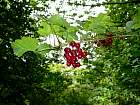Redcurrant shrub, Ribes rubrum 
shrub of the family Grossulariaceae
 Origin: Ribes rubrum and R. nigrum are native to the North and to the east of Europe. Cultivars, producing big berries, were obtained in Belgium and in France in the XVIIth century. Origin: Ribes rubrum and R. nigrum are native to the North and to the east of Europe. Cultivars, producing big berries, were obtained in Belgium and in France in the XVIIth century.
Habitat: the redcurrant shrub prefers a cool earth.
Hardiness: zone 4. The redcurrant shrub is very resistant to cold, since it can resist gels in the order of -35°C and more.
Height: 1,50 m to 1,80 m tall.
Shape: globose crown.
Numerous trunk. Flexible stems.
Deciduous foliage. Disposed in spiral, leaves are 5-lobed. They are fine.
Flowers in spring, of greenish predominant colour, grouped in racemes falling down.
Fruits in pendulous clusters by 3 - 10. The redcurrant is a small round berry at least of 1cm of diameter, white, red or pink.
Use: the redcurrant is rich in votamine C, juicy, acidulous. It can be eaten rather cooked in stews - it communicates a sour taste to dishes - or jelly usually crafted from ripe fruit just as they now contain more pectin. Redcurrant is credited with properties febrifuge, laxative, diuretic.
Propagation: the mode of multiplication of the redcurrant shrub is cutting, very easy to accomplish in autumn.
Other species:
Ribes spicatum (Europe and North of the Asia), R. schlechtendalii (Northeast of Europe), R. multiflorum (Southeast of Europe), R. petraeum (Southwest of Europe) and R. sad (North America).
|